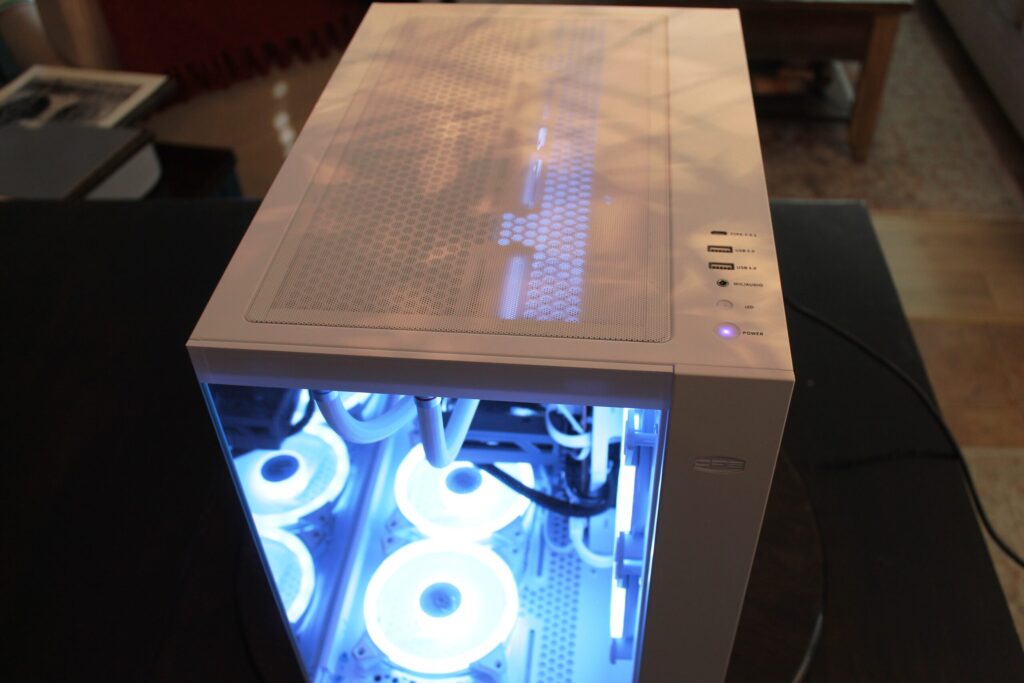The discussion around All-In-One (AIO) CPU coolers versus custom loops will always be ongoing. However, recently there has been a lot of innovation in the AIO market by manufacturers to try to match the performance and customizability of custom loops. Corsair, not to be outdone by its competitors, is launching its next-generation AIO CPU cooler, the iCUE LINK Titan RX RGB. The Titan combines Corsair's latest advancements in cooling engine technology, replaceable pump caps, and iCUE LINK RX120 fans in hopes of being your next CPU cooler.
In addition to the Titan AIO, Corsair supplied me with three of its CapSwap modules. This review will examine the iCUE LINK LCD Screen, VRM Fan, and Pump Cap Groove modules. Is the Titan good enough to topple another AIO I've recently reviewed, the Cooler Master 360 Ion? Continue reading to find out.
 ExtremeHW is excited about its opportunity to review three new products being introduced to market. Not only are these the first products under review for our friends at PCCOOLER, but they are also extra special because they are coming to market under the new brand name CPS. If you have been paying attention to the evolution of personal computing, the PCCOOLER brand should be a familiar one. Since the company’s founding in 2005, Shenzhen Fluence Technology PLC have engaged in the R&D and manufacture of PC hardware products including CPU coolers, RGB case fans, computer cases and PC power supplies under the brand name PCCOOLER. With more than 500 patents under their belt, the introduction of the CPS brand heralds the birth of the flagship product line that is surely going to cause some disruption.
ExtremeHW is excited about its opportunity to review three new products being introduced to market. Not only are these the first products under review for our friends at PCCOOLER, but they are also extra special because they are coming to market under the new brand name CPS. If you have been paying attention to the evolution of personal computing, the PCCOOLER brand should be a familiar one. Since the company’s founding in 2005, Shenzhen Fluence Technology PLC have engaged in the R&D and manufacture of PC hardware products including CPU coolers, RGB case fans, computer cases and PC power supplies under the brand name PCCOOLER. With more than 500 patents under their belt, the introduction of the CPS brand heralds the birth of the flagship product line that is surely going to cause some disruption.
We insist on technological innovation. There are four major research and development system of company: the Industrial Design Center, the Heat Transfer Lab, the Optoelectronics Lab and the Quality Control Center. Till now (by the end of Nov 2020), PCCOOLER has obtained 514 authorized patents, awarded “China’s Patent Excellence Award” by State Intellectual Property Office, “Guangdong patent award” and “the Third Prize of Science and Technology of Gunangdong Province award” by people’s Government of Guangdong Province, “Shenzhen Patent award” and “the First Prize of Scientific and Technological Advance Reward of Shenzhen” by Shenzhen Municipal People Government.
Source: CPS-Groups
The Good Stuff
The first product entering the arena is the CPS RZ620 BK dual-tower air cooler. We will then shift our attention to the CPS DE360 dual-pump AIO liquid cooler. Lastly, we will explore the panoramic virtues of the CPS C3 T500 ARGB ATX case. A distinguishing trademark feature of the CPS flagship product line is what they are referring to as “TRIFORCE” Design Language. It will be a highly recognizable aesthetic element. It is built on the Roman numeral “III” and combines triangular geometric shapes, signifying a focus on craftsmanship and elegance. You will see glimpses of “TRIFORCE” throughout all of the CPS-branded products offered by PCCOOLER.
Well, we have a ton of information to cover, so let’s get started.
What CPS Wants You to Know
RZ620 AIR COOLER PRODUCT OVERVIEW
The first high-end CPS series dual-tower air cooler features six heat pipes and features their new “TRIFORCE” design. The cooler has reverse-gravity heat pipes that allow cooling needs to be met regardless of the installation orientation. It works equally effective in a vertical or horizontal installation. The cooler incorporates dual high-performance fans that feature three operating mode (silent, performance and turbo). This allows the user to strike a balance between noise and performance, as individual needs dictate.
So, let’s take a few minutes to look at the specs and the marketing material for this product.

Clicking on any of the gallery images below will open them in an overlay. Click outside of the images to close the overlay.










Something we do not see often enough, CPS has given us a table to compare the RZ620 to popular models it designed it to compete with. This is super-useful and I wish all manufacturers would do this. The one piece of data missing from the comparison is the TDP of each. You would need to do your own research here, and I suspect the reason it is not provided is because some manufacturers do not disclose it.
DE360 HIGH-PERFORMANCE AIO PRODUCT OVERVIEW
The evolution of AIO CPU coolers has been a bit of a phenomenon over the past couple of years. It was not too long ago that they were viewed as a noob compromise to a proper liquid cooling setup, but things have improved to the point that the better models rival CPU cooling of a comparable custom loop. For the uninitiated or the unmotivated, a good AIO can be a better choice in terms of convenience, ease of installation and affordability. PCCOOLER has been exploring the performance of liquid cooling products so it makes sense they would set out to do something unique for the premium CPS product. The vast majority of what AIO shoppers are going to find is a single pump solution. Given that these are not normally robust pumps, there will be some heat dissipation limits. The wizards at CPS have one-upped the competition here with a revolutionary dual pump solution as the CPS standard. Sound exciting? Let us now take a peek and see what the specs and marketing materials tell us. Perhaps we should be excited. 
Clicking on any of the gallery images below will open them in an overlay. Click outside of the images to close the overlay.
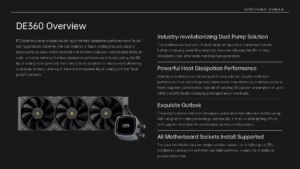







And, once again, CPS goes the extra mile and shared how their DE360 stacked up against a couple of competing products during in-house testing. It shows a great deal of pride in what they are bringing to market.
C3 T500 ARGB PRODUCT OVERVIEW
Saving the best for last, the pièce de résistance for today’s review, CPS has some stuff they want to call our attention to about the C3 T500. As if they need to say much; it doesn’t take a degree in rocket science to recognize beauty when it smacks you across the noggin. Grab a napkin for the drool and read on. The gory details about the SPCC cold-rolled carbon steel knight in shining armor follow.

Clicking on any of the gallery images below will open them in an overlay. Click outside of the images to close the overlay.


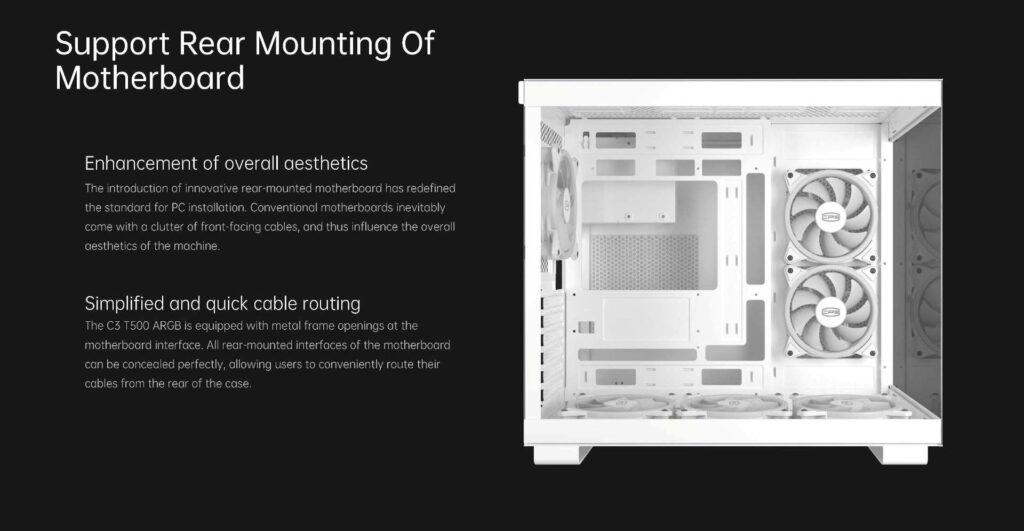





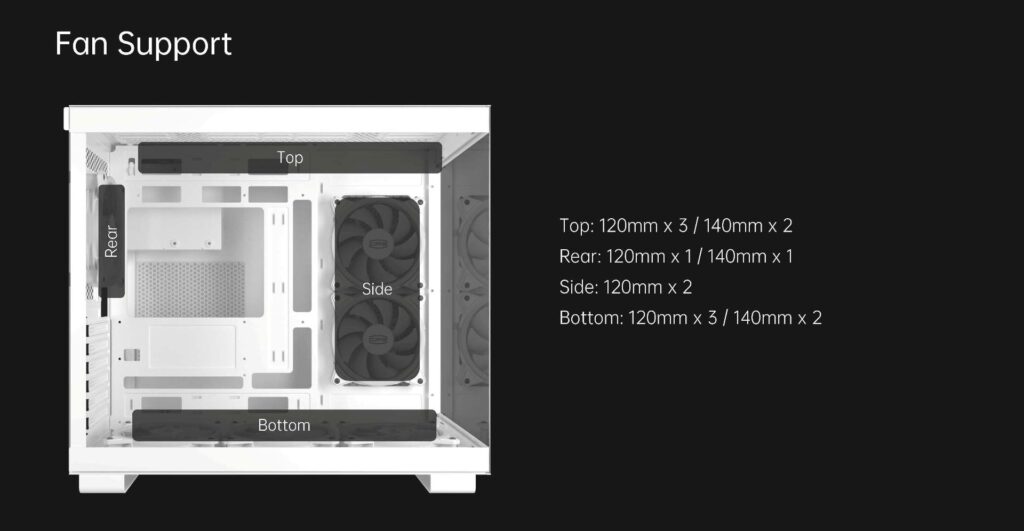







What ExtremeHW Wants You to Know
With three amazing components to review there is still much left for us to cover. So, what we will do is start with unboxing and initial impressions for each product. From there we will move to cooler testing. Then we will look at original donor system and examine the final build. We will conclude with a summary of final impressions and product ratings for each component.
Initial Impressions
RZ620 AIR COOLER
To be honest, I have never been a fan of air cooling. But, I know there are many computer enthusiasts that are, and finding a good one is key in avoiding headaches. Not only does the cooler need to be pleasant to install, but it also needs to do a good job of cooling or it is not worth having. And, of course, it needs to look good or nobody is going to want to use it. Most of us care how our system looks nearly as much as we care about how it performs. Let’s get a closer look at the RZ620.
The CPS RZ620 ships in packaging that reflects pride in the product contained in the box. The contents are packaged well and protected accordingly. The instructions it comes with are very clear, easy to follow, and the parts are packaged in a way that makes them easy to identify and reconcile with the installation instructions. A tube of CPS EX90 thermal compound is included.
The cooler itself looks fantastic. No information was available to confirm a white option will be available, but given the model number ends in BK, logic suggests that a white version will be available at some point. The “TRIFORCE” aesthetic is pleasant and the quality of the cooler, fans and components are top notch in terms of appearance. If you are a fan of air cooling, I cannot imagine anyone not liking it in terms of appearance. In all respects, PCCOOLER hit a home run on first impressions. So, we will take a look at the packaging and parts. Feel free to watch the short unboxing video and browse the gallery below.
Clicking on any of the gallery images below will open them in an overlay. Click outside of the images to close the overlay.








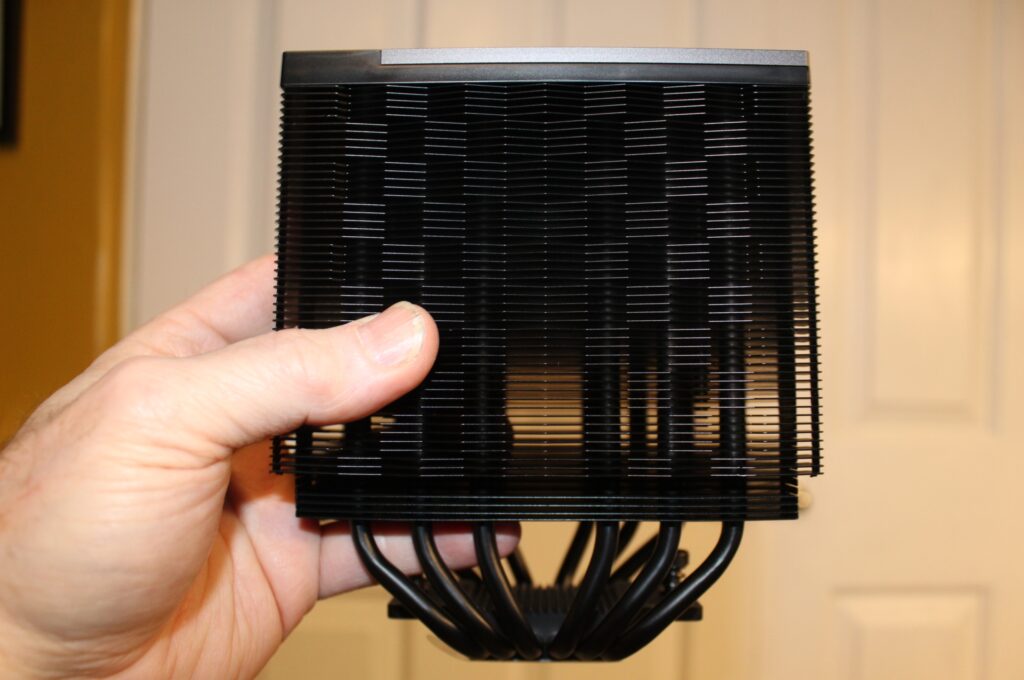



When it came time to install it, everything went smoothly. Installation was a breeze. The included EX90 thermal paste was easy to apply. The manner in which the fans daisy-chain made it nice to only have to deal with a single fan cable. The one watch out that veterans of air cooling will want to know is memory clearance is tight. The G.SKILL Trident Z5 memory modules had some contact interference with the outer fan and caused the fan to protrude a few millimeters past the top of the tower top cover. This was mitigated by positioning the center fan to match. It did not look bad by any count, but those with taller memory modules should be aware that fit could be an issue, as it often is with other brands.
DE360 WH HIGH PERFORMANCE AIO COOLER
Liquid cooling has always been my preference, so I was eager to see how the DE360 looked and performed. I was as impressed, if not more so, with the quality look and feel of the DE360 compared with the RZ620. The product was packaged in such a manner that the contents would be protected and survive all but the most abusive shipping treatment. Other than being run over by a truck or being impaled by a Samurai sword, I cannot image it suffering any kind of damage due to rough handling. Again, the packaging reflects a great deal of pride in the CPS brand. So, let’s have a gander at the kit in the brief unboxing video and photo gallery that follows.
Clicking on any of the gallery images below will open them in an overlay. Click outside of the images to close the overlay.
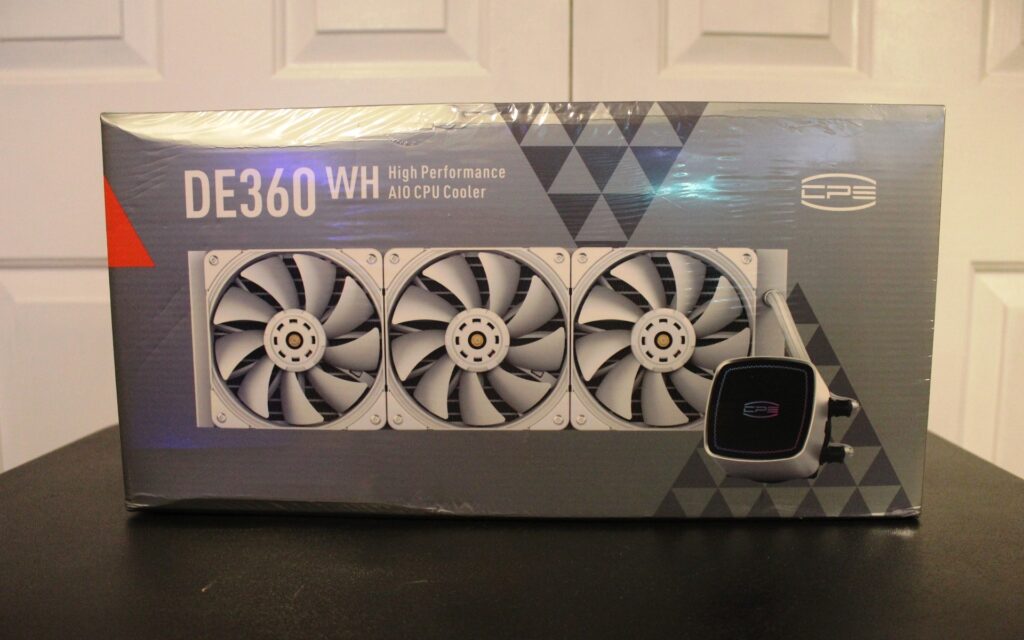



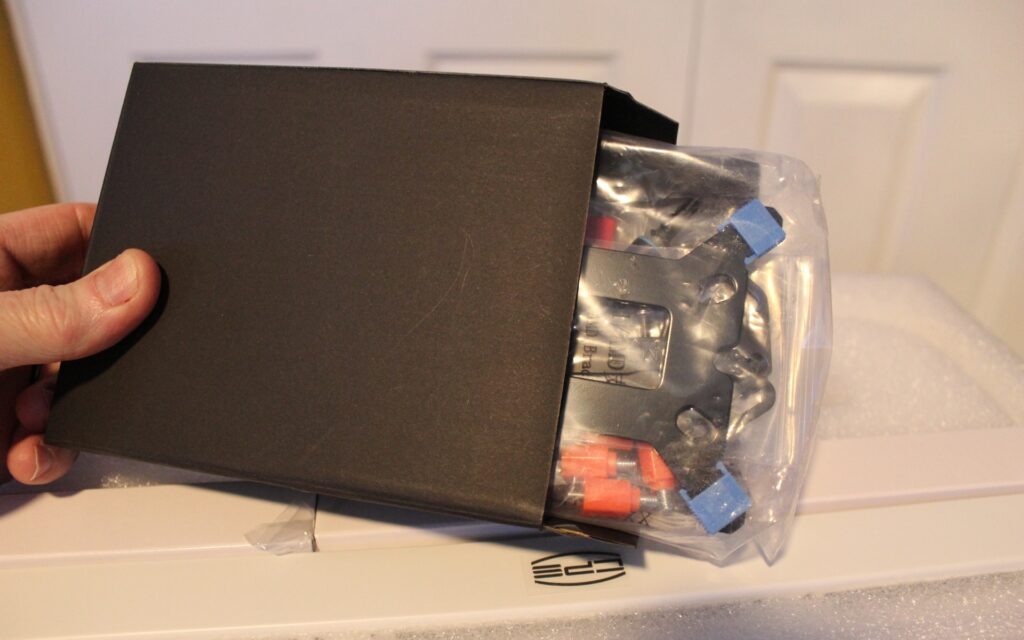







Like the RZ620, the parts are packaged in a way that components are easily identified and reconciled with the instructions. Installation was uncomplicated. The rubber tubing was more than long enough and should accommodate the largest full tower case installations. The braided covering on the tubing and the rotary fittings on the ends screamed quality in terms of appearance. The finish on the radiator was excellent. There were no unpainted bare spots and the smooth, semi-gloss finish was excellent, The CPS logo on the side of the radiator is a raised plastic decal with a bright silver finish that has an elegant look to it. The pump housing has a pleasing silver finish that compliments the white build, and the RGB top on the pump is tastefully understated and lends to an elegant build. This is in contrast to the garishness of some of the AIO pump spastic rainbow RGB accents that have become common.
The way the three 120mm fans daisy-chain and terminate with a single wire leading to the motherboard is excellent and should be the standard that all brands are following in 2023 and beyond. There is no excuse for having to manage multiple fan wires, so kudos for PCCOOLER for caring enough to do this right. The only thing that some will find potentially disappointing in this model is the fans are not RGB. The fans have no lighting feature.
C3 T500 ARGB MID-TOWER CASE
If the case reminds you of a Lian Li O11D at first blush, I guess that means you haven’t been living under a rock. It should, and their is nothing wrong with that. The rear chamber and panoramic build display is an excellent design and who would not blame a competitor for producing a similar product that makes so much sense. They would be silly not to offer a variation of their own. I have always preferred black, but I am not going to lie… it’s gorgeous in white. Drop-dead gorgeous to be completely honest. As you already know from the introduction section above, the case has lots of good features, but we are going to get a much closer look at discovering more through the brief unboxing video and image gallery that follows.
Clicking on any of the gallery images below will open them in an overlay. Click outside of the images to close the overlay.









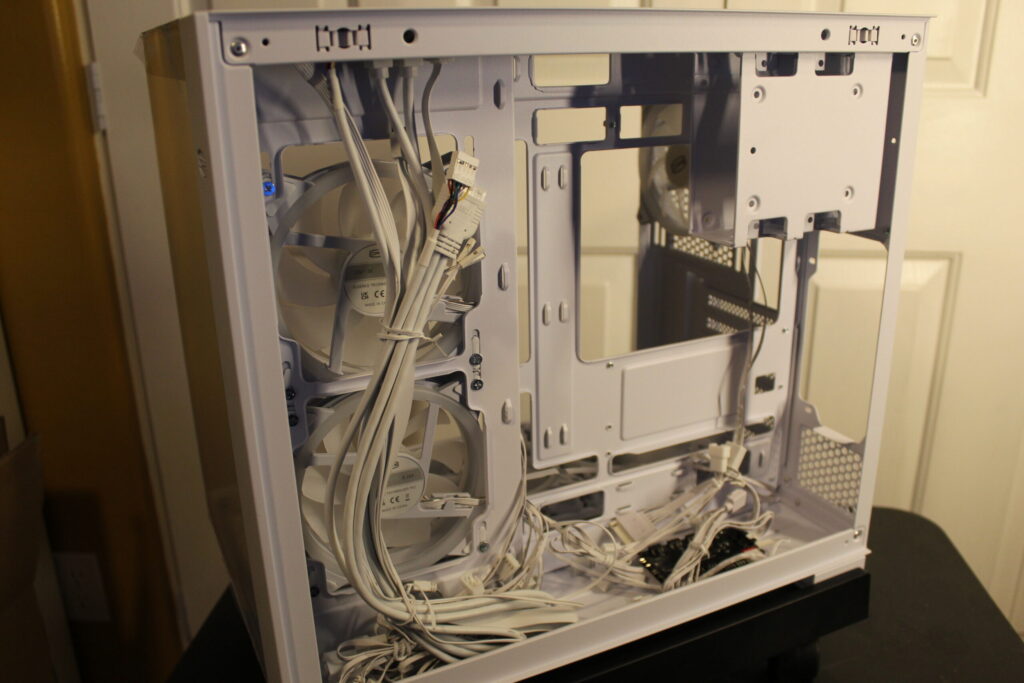










C3 T500 ARGB BUILD EXPERIENCE
Well, the time has come to stop showing off the parts and talking about what makes them special and move on to the build experience.
The donor of the components going into the build belongs to one of my sons and he will ultimately become the proud owner of the end product. While the internal components are relatively new, the case is more than a decade old, looks accordingly dated, and does not accommodate liquid cooling. Some of you fellow old-timers will recognize it as an NZXT Phantom, circa 2012.
We will initially complete the build using his existing air cooler, which is a be quiet! Dark Rock Pro 4, which is coincidentally one that CPS identified in their RZ620 market comparison. We will runs some thermal tests, install the RZ620 for comparative testing, and ultimately land on the final build and thermal testing with the DE360 AIO.

The C3 T500 was a pure joy to build it. I love the fact that the chassis is made of heavy duty cold-rolled carbon steel instead of aluminum. It is quite sturdy. For a mid-tower case it is roomy and will accommodate air or liquid cooling equally well. It is big enough to handle the largest graphics cards and only has limitations with the largest power supplies and E-ATX motherboards (neither of which will fit). The fit and finish of everything is nothing short of excellent. Nothing was difficult and I never found myself looking for a workaround or resorting to trial and error in an effort to make something fit. I am generally a fan of large full-tower cases and this case felt big in spite of its svelte profile. One area where mid-tower cases often cause some frustration and disappointment is placement of the top panel radiator. The C3 T500 has plenty of space up top for the radiator and fan. Attaching the CPU power connections is not challenging and the radiator fans do not encroach on the memory modules or VRM heatsinks. A lot of little things like this suggest that PCCOOLER was thoughtful and deliberate in their engineering of the case. We can’t say as much for the stuff we often see from some of their competitors.
One more thing that I love about the case is the built-in ARGB controls. They are basic, but many of us prefer a static color. Most of us do not want or need anything elaborate, we just want to stop the rainbow puke and set a color we like. My preference is static white regardless of the build color. The real beauty and benefit of this is the absence of any need to install or use the rubbish software that has become so common. It’s generally software that is buggy, wastes a ton of system resources, hinders benchmark scores and sometimes only works with some of the components; meaning you may need to install more than one software application to control the lighting on all your stuff. NOT HERE! No need to use the motherboard RGB headers. Use the button on the top panel I/O and say goodbye to the bloatware. This is not an exclusive feature to this case, but it pleased me greatly to see PCCOOLER employing customer-centric design intelligence on the CPS C3 T500.
Before we move on to the cooler testing, below is a video montage showing variations of the build and demonstrating the ARGB features the case offers. Also included is a random assortment of build images in no particular order of importance.
Clicking on any of the gallery images below will open them in an overlay. Click outside of the images to close the overlay.





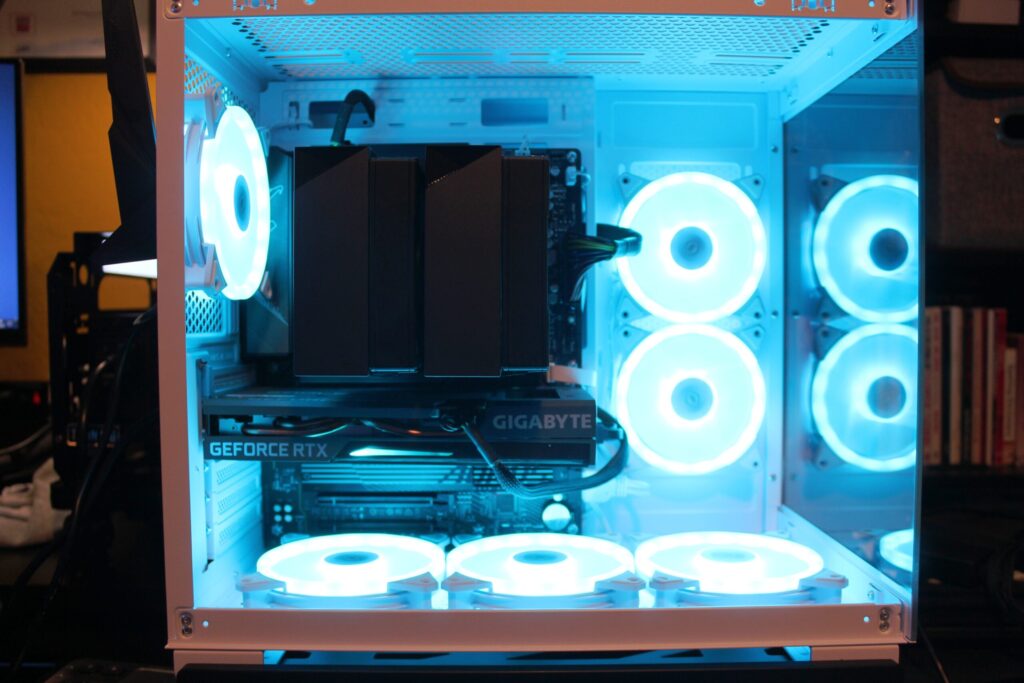


COMPARATIVE COOLER TEST RESULTS
Being an Intel-guy, I was a bit out of my element doing thermal testing on a Ryzen AM5 build. My son runs his AMD Expo (XMP) DDR5-6000 profile and has the most basic PBO option enabled. He is an avid gamer, but not an overclocking lunatic like his dad. My intent was to not disturb any of his settings and to do the testing in a configuration that likely resembles the majority interested in building a gaming PC.
Testing was done with PBO enabled and Expo/XMP applied (my son’s default configuration) in an ambient temperature of 76-78°F with the tempered glass side panel removed. The intent was to compare the coolers without any influence relating to case air flow or internal chassis temperature variance. The CPS EX90 thermal paste was utilized with all three coolers. All three coolers were run at maximum fan speed during a 15-minute OCCT CPU stress test. 
I was not expecting the the Ryzen behavior where PBO boosts to the thermal limit and backs off. That made me have to stop and analyze the results to understand them better, where it may have been more obvious on an Intel system or with manually overclocking of the Ryzen CPU. Another thing I was not expecting is to see the RZ620 holding its own against the far more expensive Dark Rock Pro 4. The CPU ended up boosting and holding the clocks a bit higher for a higher average clock speed for the RZ620, and having a fractionally lower CCD1 maximum temperature than the Dark Rock Pro 4. The RZ620 has one less heat pipe, but seems to have stronger fans. Even looking at test results with the AIO, there was not a massive spread in results amongst the three. As expected, the AIO had a little bit lower maximum temperature, which allowed the CPU to pull more power, add more voltage, boost and hold a higher average clock speed compared to the air coolers without thermal throttling.
Thermal test results are captured in the data presentation below. You can enlarge the image below for better viewing by clicking it.
CONCLUSIONS AND PRODUCT AWARDS
Well, the time has come to wrap this up and render a verdict. If it isn’t obvious that all three CPS products covered in this review were anything less than great products it would seem that reading comprehension is not an area of strength. PCCOOLER really did things right with the launch of the CPS sub-brand. I think if they continue to focus on quality there will be no limit to the great products we see coming from them. This is most refreshing in an era where quality and consistency are rare.
A few things could be improved with minor modifications, but none of them presented serious challenges or disappointments. The list of suggestions is a short one.
- Adding a few millimeters for memory clearance would be useful for the RZ620, but it could also limit case compatibility.
- The spacing between the bottom of an ATX motherboard and the chassis floor is tighter than it should be. Running wiring from the bottom edge connections is too restrictive. Adding 8-10mm of extra clearance here is recommended. It wasn’t a deal-breaker, but it is the only real “con” to the design of the C3 T500 I can point to.
- Making the bottom air filter for the C3 T500 a slide-in unit is recommended. Depending on where the case is situated, it could be awkward fussing with the filter, and if the magnet grows weak in time it will be falling off due to nothing more than gravity.
- Suggested future enhancements for the C3 T500 would be a manual fan control feature for those that wish to bypass firmware controls. That feature for the ARGB is priceless and would be equally valuable for fan controls.
- I would also love to see an XL version with support for E-ATX, triple 420mm radiators, space for exotic custom loop cooling and massive power supply units.
All three products are due for launch by November 20 in the United States and UK and around November 25 in European markets. PCCOOLER provided us with pricing for all three products and I have to say they are compelling at the prices provided to us. US buyers should expect to pay $100 for the C3 T500, $70 for the RZ620 and $130 for the DE360 if the pricing holds true. Hopefully we will not see any monkey business going on with above-MSRP pricing that has become so common with PC components.
At the date of writing (November 20) only the RZ620 was found in a search on Amazon. The RZ620, DE360 and C3 T500 are not listed in the PCCOOLER Amazon Store but should be available for purchase very soon, if not already at the time you are reading this review.
We sincerely appreciate the privilege to review these excellent new products prior to their launch. They are all of very good quality and perform well. Therefore, we have no reservation recommending them.
Want to discuss this product or give your views and feedback from your own usage? Leave your comments and discuss HERE, on the ExtremeHW Forums (No Sign Up Required)
Like our content? Please consider Donating to help us to continue our writing.










